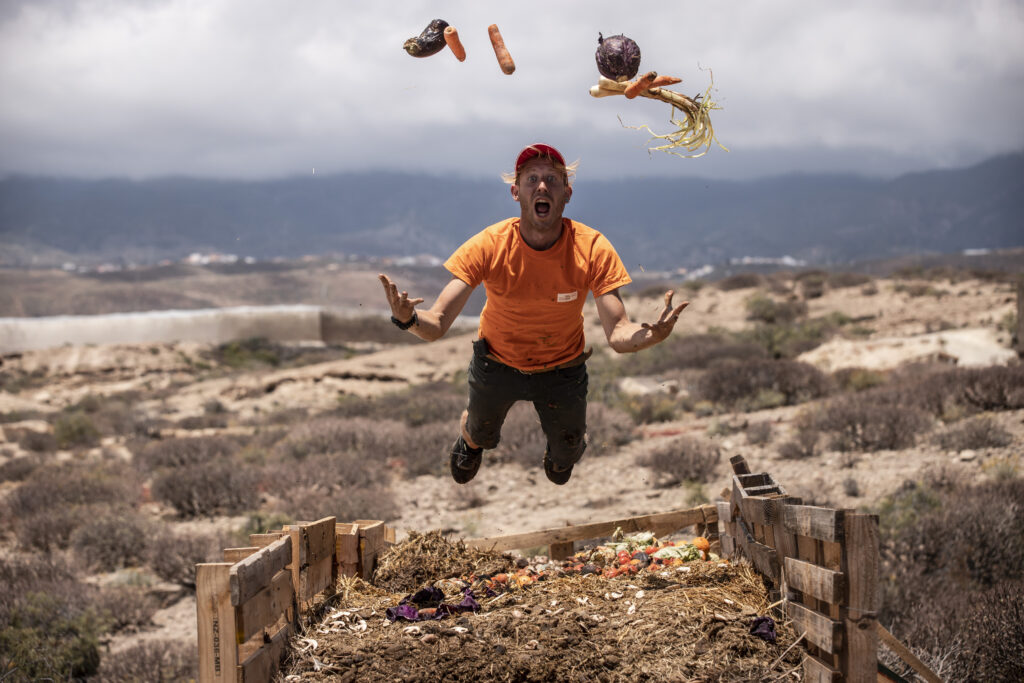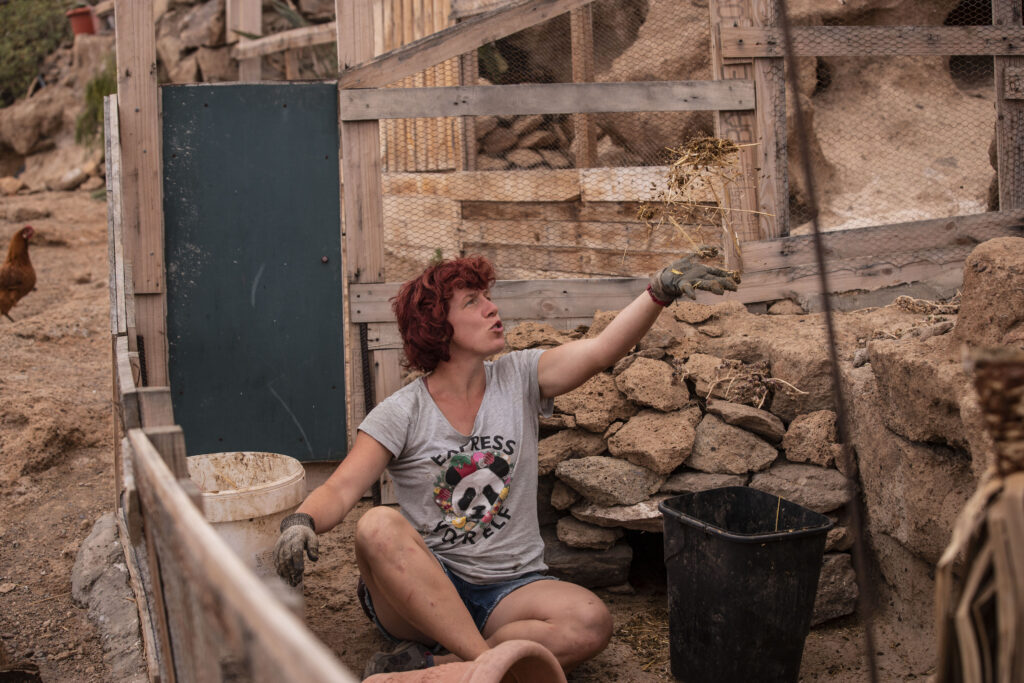How to make compost
How to make compost



How to make compost is this weeks “how to with Lola”
As an Eco Animal Sanctuary, we are very committed to sustainability and making compost is a must and a daily task for us. Also the fact that we live on a farm with a lot of horses and a big amount of fruits and vegetables waste makes composting much easier and it became an essential part of our work and lives. In this post you will learn how to make compost and all its benefits. For the occasion, we interviewed Chiara, one of the compost team volunteers at Tenerife Horse Rescue.
Chiara is from Italy and arrived at our rescue center one week ago. She studied environmental science and has a degree in compost. She also did a special research on composting with eco bags, that we will mention later. We were really lucky to meet her and learn all about composting. Would you like to learn how to make compost? Keep reading!
What is compost
Compost is a mixture of natural ingredients used to fertilize and improve soil in order to grow plants. Basically, the purpose of compost is to give all the nutrients that the soil needs and which the plants will use to grow strong and healthy. Compost improves soil structure. Adding compost to the soil will give a better texture, water-holding capacity and fertility. Your soil will gradually become fluffy and brown, the Ideal home for healthy plants.
The importance of making compost
Even if you have a great soil, we can not expect that it regenerates the nutrients by itself. That’s why composting is so important. Because it helps the soil to maintain the nutrients it needs. Compost provides a balanced source of plant nutrients. There is no commercial fertilizer, even one that is totally organic, that provides all the nutrients that you get with compost. Adding compost also moderates pH and fertility problems.
“The positive thing about compost is that it can be applied at any time and in any amount. Plants use exactly what they need, when they need it. There is no chance to over use compost. It’s never too much”.
Chiara
Most common ingredients
You can make compost with dry components, fruits and vegetables, protein (in a small amount) and water. First of all, Chiara recommends putting in the dry stuff. The common dry ingredients are: corn cobs and stalks, pine needles, straw, vegetable stalks, dry leaves and sticks from any plant. These ingredients are very important because they absorb the water and balance its amount. If there is too much water then the bacteria drawn and the process is interrupted.
After that, she adds old compost ready to use. This will accelerate the process and make it easier.
Finally, we can add the fruits and vegetables an other food waste such as coffee grounds, eggshells, seaweed and other kitchen scraps. They should be cut in the same size pieces, not bigger than 5 cm. It’s important not to add too many proteins because they produce ammonia and this turns into nitrous oxide, a greenhouse gas that is really bad for the planet. Like other greenhouse gases, nitrous oxide absorbs radiation and traps heat in the atmosphere, where it can live for an average of 114 years. So we don’t want to produce that gas.
“In Tenerife Horse Rescue, we are building big structures of compost that in the future we will use for our own garden and hopefully sell. Here we have the possibility of adding horse poo that is really rich in nutrients. We need to be careful with the wind because the compost gets dry very fast, so we cover it with mosquito nets, and check the temperature more often“.
Chiara

How is the process
The organic matter transforms into compost through the work of microorganisms, soil fauna, enzymes and fungi. The bacteria will eat and convert all the nutrients provided by the organic matter and when the bacteria dies, all these nutrients go to the compost, and later, the soil.
When making compost, your job is to provide the best possible environment for these beneficial organisms to do their work. That is why it is really important to constantly check the temperature and level of wetness of the compost. The temperature needs to be between 40 and 70 degrees. If it is too low, the process can not start. And if it’s too high, the bacteria could die before the process ends.
“You can always fix the compost. If it is too hot we can remove it so the air can pass through the compost. If it’s too wet you can add more dry components and remove again”
Chiara
To measure the temperature you can use a thermometer. If you don’t have one you can also do it with sticks, and then check with your hands how hot it is.
Compost phases
To better explain the different phases of compost, we took some details from Nancy Trautmann and Elaina Olynciw research. Basically there are three types of microbes that work to digest the materials in a compost pile. They each work best in a particular temperature range. We could separate this process in these three phases:
1) The mesophilic, or moderate-temperature phase, which lasts for a couple of days and rapidly breaks down the soluble, readily degradable compounds. The heat they produce causes the compost temperature to rapidly rise.
2) The thermophilic, or high-temperature phase, which can last from a few days to several months. The high temperatures accelerate the breakdown of proteins, fats, and complex carbohydrates like cellulose and hemicellulose, the major structural molecules in plants. And finally
3) a several-month cooling and maturation phase where the compost temperature gradually decreases and mesophilic microorganisms once again take over for the final phase of “curing” or maturation of the remaining organic matter.
When compost is ready
Compost takes from four to five months to be stable and ready for use. To check if everything is alright we have to put some water inside, and if the temperature is the same as the air temperature, it means it is ready to be used.
It’s really important to make a good check because if it is not ready to use, instead of giving the nutrients to the plant, it will take them away from it and the process will start again. When you have your compost ready, you just mix it with soil, and you will be able to grow whatever plant you want. This is the best fertilizer you can ever find.
Composting at home
Composting at home is the same as in a farm with a different dimension. You just need a separate bin for all the compostable food. Don’t worry, it is not going to smell. If it does, it is because ammonia is being produced, so you probably need to remove the compost and add some dry stuff. As we said before, it is very important to check the temperature and level of wetness. This will guide you to have the best balance as possible and avoid a disgusting smell in your kitchen.
As Chiara researched, these microbial bacteria also digest bio bags, along with food and yard waste, to become soil or fertilizer. So you can completely add them to the compost bin. These bags are often made of maize, an easy compostable ingredient. Chiara suggests using the thinner ones, that take less time to be digested.
Just remember: the term “compostable” refers to any material capable of breaking down into carbon dioxide, water, and biomass at the same rate as cellulose. Compostable materials must be able to disintegrate and become indistinguishable in the compost and cannot leave any toxic material behind.
I hope that all this information has been useful to you and motivates you to make your own compost at home. In addition to being a high quality natural fertilizer, it is an alternative to improve the quality of the air we breathe, reducing the burning of garbage that produces smoke, ashes, and toxic products.
If you can not make it at home in the near future we will be selling our own compost for you to use and all proceeds will go directly to the animal sanctuary. Sustainable fundraising!
Here you can find information about waste management in the EU.


Giving to us on a regular basis means that not only can we keep you completely in the loop as to where your money is going, and how it is being used to do good, but we will also assign you your own personal log in details to receive insider information about our project and our plans. You will be informed first of all updates, allowing you to be a closer part of our journey with us.













